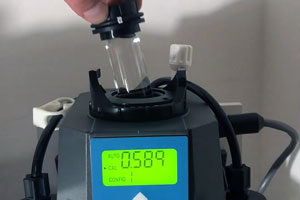3/27/2024
| Dr. Patrick Wolf
Turbidity is considered one of the most important indicator parameters in drinking water monitoring. Accurate measurement of turbidity starts at the commissioning stage. In this article you will find the most important steps briefly explained.
The turbidity – one of the most important parameters
 As an indicator of contamination, turbidity is one of the most important parameters for determining the quality of drinking water. The defined limit value of 1 NTU and often used significantly lower warning and alarm values of the operators require a high accuracy of the measurement. After all, no one wants to be unnecessarily alarmed or even awakened at night, and certainly not to provide deficient drinking water. Analyzers offer these high accuracies and meet the demand for standard-compliant measurement according to DIN 7027 or EPA 180.1.
As an indicator of contamination, turbidity is one of the most important parameters for determining the quality of drinking water. The defined limit value of 1 NTU and often used significantly lower warning and alarm values of the operators require a high accuracy of the measurement. After all, no one wants to be unnecessarily alarmed or even awakened at night, and certainly not to provide deficient drinking water. Analyzers offer these high accuracies and meet the demand for standard-compliant measurement according to DIN 7027 or EPA 180.1.
The most important steps during commissioning
However, the metrological requirements are not the only solution. Commissioning is also crucial. In addition to basic system settings such as time and date or the standard installation of a desiccant bag, there are some steps that are crucial to comply with the specifications. This article describes important steps for our Turb PLUS 2000 turbidimeter. It is available in two versions – the Turb PLUS 2120 with infrared or the Turb PLUS 2020 with white light.
Set measuring range

Software update via USB stick
The first measure during commissioning is the selection of the correct measuring range. In many cases, this should be 0 ... 10 NTU, the measuring range with the highest accuracy. This measuring range is made possible with the Turb PLUS series by a software update using the USB stick supplied. If the stick itself or the software files on the stick are no longer available, the software can also be downloaded free of charge from the product page of turbidity analyzer.
Calibration with the right standards
After a measuring range change, the analyzer must be calibrated for the newly selected measuring range. Suitable calibration kits are available for each measuring range.
Our calibration kits:

Inserting the cuvette in the calibration process
- Measuring range 0 ....10 NTU Order number: 600056
- Measuring range 0 ...100 NTU Order number: 600054
- Measuring range 0...1000 NTU Order number: 600052
For the calibration itself, the calibration cuvettes must first be indexed. To do this, the calibration cuvettes are rotated in measuring mode until the lowest measured value is reached. This position is marked on the calibration cuvette by means of a ring to define the correct orientation.
During the actual calibration, the instrument requests those standards that are included in the corresponding calibration kit. In order to achieve the best possible calibration and a correspondingly accurate measurement, care must be taken to ensure the cleanliness of the calibration cuvettes.
The frequency of regular calibration in operation varies somewhat from case to case and sometimes also depends on internal quality assurance specifications. As a rule, however, it is between 3 and 6 months.
Set and adjust mA output

Set and adjust mA output
The added value of an accurate measurement is lost if the transmission to a higher-level control system is faulty. This primarily includes the scaling of the lower (4 mA) and upper (20 mA) output value to the selected measuring range.
Another decisive point is the adjustment of this output signal with the input signal at the control system. If these differ for technical reasons, the output of the analyzer can be adjusted. To do this, increase or decrease the counters in the "Configuration/4mA" and "Configuration/20mA" menus until the signals match. The two menus are only available if the mA output has been activated ("On") in the "Configuration/4-20mA" menu.
If the analyzer is mounted on our Drinking Water Panel, the output signal can also be transmitted to the IQ Sensor Net via an MIQ/IC2 module. This offers the advantage that all measured values as well as their data transfer to the control system are available or can be maintained on one system. Thus, the system enables clearer and simpler work.
Measuring cuvette and filling
As soon as all settings have been made, the device is filled with the measurement medium. Before this, the flow-through cuvette must be removed in order to remove the desiccant bag it contains. It is advisable to observe the flow-through cuvette during filling in order to detect any leakage after it has been screwed back in. Only when this can be ruled out can the cuvette be reinserted in the instrument.
To the products:
Continuous turbidity measurement with Turb PLUS 2000
Calibration kits
Drinking water chart including turbidity, pH, conductivity and more
Portable Turbidimeter Turb(R) 430 IR
Turbidimeter for the laboratory Turb(R) 750 IR